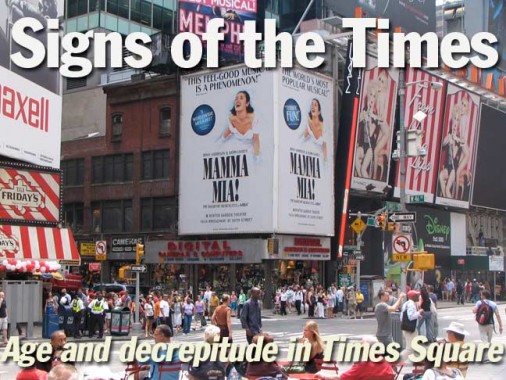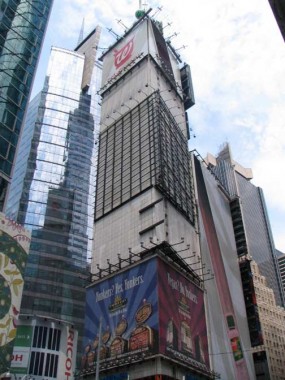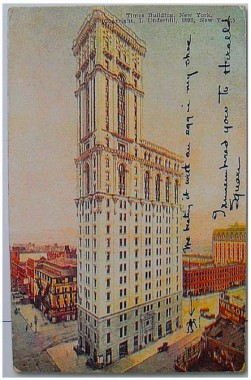Broadway crosses 5th, 6th, 7th and 8th Avenues south of Central Park, but the crossing with 7th Avenue is so gradual (I don’t know where to find this out, but it must be at an angle of less than 20 degrees) that there’s about a 4-block stretch when the avenues merge and become one wide road. This is Times Square, the Crossroads of the World, and a place where I rarely venture — in my youth because of its crime-ridden nature (I was missing out, as there were legit movie houses here playing stuff you just couldn’t find elsewhere) and since the Giuliani Era, because of its franchise-dominated touristiness.
However, I’m fascinated with Times Square for reasons completely unknown to the out-of-towners that flock there year-round. It’s a total fake-out. Despite the gleaming new towers constructed during the “New 42” era of 1995-2005, when the peeps, pornhouses and grindhouses were torn down and the fast food joints and wax museums moved in (and, to be fair, BB Kings, a concert hall I am in with some frequency) much of Times Square is decrepit, old, and creaking. Don’t believe me? Take a look at these specimens…
ONE TIMES SQUARE, constructed in 1905 as the New York Times office, is famed for being the locale of the New Year’s Eve ball drop and beginning in 1928, the site for the famed “zipper” news updates. The Times only lasted here for 8 years and moved to West 43rd Street in 1913, and to a new skyscraper on 8th Avenue in 2007.
Originally, it was an Italianate 25-story tower, the second-tallest building in Manhattan, visible for miles. The transformation to its current use as a gigantic billboard began in 1963 when Allied Chemical purchased the tower and stripped off most of the exterior, replacing it with flat marble. The top floor survived as a restaurant till the 1980s. Today, a giant Walgreens sign dominates the apex.
KNICKERBOCKER HOTEL, 6 Times Square at the SE corner of 7th Avenue and West 42nd, went up in 1906, a year after One Times Square. Unlike the Tower, it looks remarkably like it did in its heyday and one of NYC’s premier hotels.
6 Times Square, also known as the Newsweek Building or Knickerbocker Building, is a building located at 1466 Broadway at the southeast corner of 42nd Street in New York City. This historic building opened in 1906 as the Knickerbocker Hotel, “Knickerbocker” being an iconic name for New York. Built by John Jacob Astor as a showcase of luxury in a time of economic prosperity in the city, the hotel was destined to close its doors only 15 years later due to changes in fortune. The building was later home to Newsweek magazine between 1940 – 1959, and after major restoration in 1980 the building is now used for garment showrooms and offices. wikipedia
Opera star Enrico Caruso was a longtime resident, and legend has it that the martini was invented here in 1912.
When the IRT subway was first built in 1904, a door from the platform led directly into the hotel. The door remains there, marked ‘Knickerbocker’ though it has long since been blocked up.
Two views of Times Square, looking north (top) and south (bottom). I shot these in May 2010, and the pace of change has already claimed Kodak.
Auto traffic has been severely cut back in Times Square, with pedestrian plazas now making up most of Broadway’s route. A recent diversion has rerouted even more traffic away from the Crossroads since these photos were taken.
PARAMOUNT, 1501 Broadway at West 43rd, was built as the Broadway offices of Paramount Pictures in 1926, and its longtime theatre was the studio showcase for many years, with a giant Wurlitzer organ. It’s said the the movie studio’s mountain symbol is represented by the stepped roof, crowned by a gigantic clock and globe. Big band music, and later early rock & roll, were presented in the huge theatre. The Hard Rock Cafe, preceded by World Wrestling Entertainment, has dominated the ground floor for several years. The Wurlitzer is now in Wichita, Kansas.
The I. Miller Building, at 7th Avenue and 46th Street, was built from 1927-1929 and is nearly unrecognizable underneath the video billboards and garish scaffolding advertising a chain restaurant. Israel Miller’s shoe store was long patronized by theater people.
But a closer view of the I. Miller Building along 46th Street will prove to be a glimpse into the Great White Way’s past. In 1927 the I. Miller company took a public vote to determine the most popular theater actresses of the day with the idea of placing their statues on their new 7th Avenue store. The results came in and sculptor Alexander Stirling Calder was chosen to depict them in some of their most famous roles… Ethel Barrymore as Hamlet’s Ophelia, singer-dancer Marilyn Miller as Sunny, Mary Pickford as Little Lord Fauntleroy, and soprano Rosa Ponselle as Bellini’s Norma.
The Maxell ad, meanwhile, featuring the guy sitting in front of a speaker with his hair and tie blowing back from the force of the sound waves, is pretty venerable itself now — it was first used in 1980, with “Ride of the Valkyries” playing on the TV commercials.
Entertainer, playwright, composer, lyricist, actor, singer, dancer, and producer George M. Cohan (1878-1942) once needed no introduction whatever to most New Yorkers, who remember James Cagney’s portrayal of him on film, as well as the song …
Give my regards to Broadway
Remember me to Herald Square
Tell all the gang on 42nd Street
That I will soon be there
Cohan also wrote “Yankee Doodle Dandy” (even though he was born on the Third of July, not the Fourth), “Over There” and also made his mark as an actor in “Ah, Wilderness” and played FDR in “I’d Rather Be Right”.
“Little Johnny Jones”, Cohan’s first big hit musical from 1903, was revived with Donny Osmond in the title role in 1982. It was one of Donny’s biggest flops, closing after just one performance.
A brand new TKTS kiosk, with iconic red steps, has appeared behind Father Duffy in his “square.”
Father Francis Duffy of Most Holy Trinity Church on 42nd Street near Broadway served with the Fighting 69th, a mostly-Irish regiment in World War I, was severely wounded, and received the Distinguished Service Cross for bravery on the battlefield.
His monument in Duffy Square, the triangle formed by Broadway, 7th Avenue and 47th Street and dedicated in 1937, features Father Duffy in his World War I uniform standing in front of the Celtic cross.
It was here that Tony Curtis’ Sidney Falco, the unscrupulous press flack in Sweet Smell of Success, got his final comeuppance.
7th and 46th opposite the I. Miller Building. Note the ancient building behind the billboards.
On this corner, 7th and West 47th opposite TKTS, can be found one of the chief inspirations for FNY. Of course it’s invisible now, but it wasn’t when I photographed this spot in 1998…note that small building in the middle of the block that says “Heights…”
There’s an ad for carriage repairs on it dating to about 1875-1880. Times Square, long before any showbiz moved in, was once where you bought and sold horses as well as the carriages they pulled. The ad was covered up a few months after I got the shot, and may still lurk under there now.
Photographed 5/10; page completed 2/3/12



